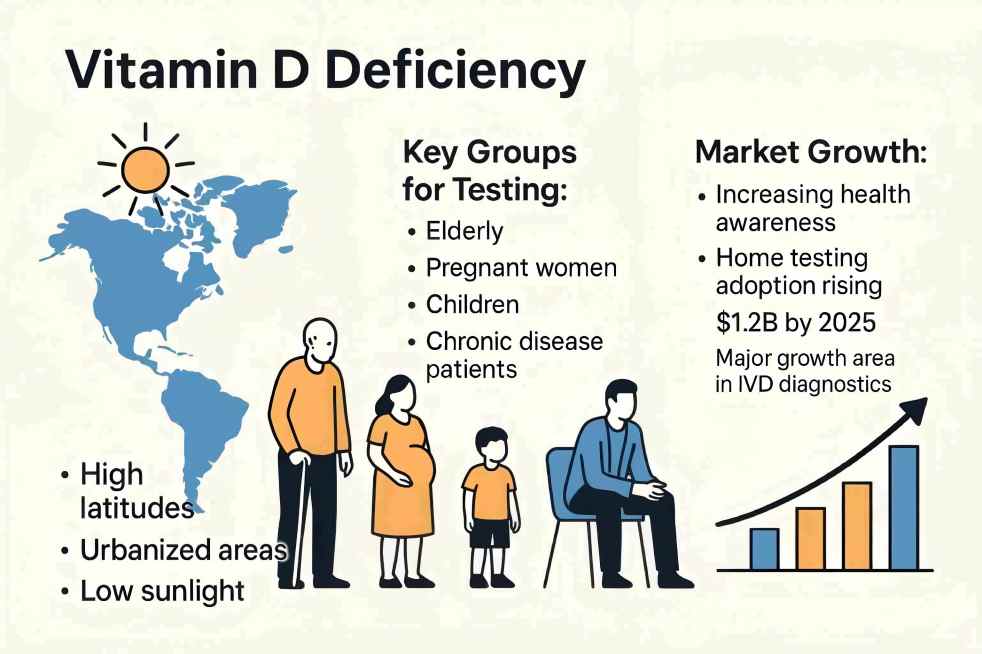Vitamin D plays a critical role in maintaining bone health, supporting immune function, and reducing inflammation. With growing awareness of vitamin D deficiency and its health implications, more people are seeking ways to accurately check their vitamin D levels.
1. Why Test for Vitamin D?
- Vitamin D deficiency is surprisingly common, especially in individuals who:
- Spend limited time outdoors
- Live in areas with limited sunlight
- Follow vegan diets or have digestive conditions
- Are elderly, obese, or have darker skin
- A deficiency in vitamin D can lead to:
- Osteomalacia or rickets (soft bones)
- Increased risk of fractures
- Weakened immune response
- Muscle weakness and fatigue
Routine testing is essential for at-risk individuals or anyone wanting to optimize their long-term health.

2. Common Types of Vitamin D Tests
There are two primary forms of vitamin D that can be measured in the blood:
|
Test Name
|
What It Measures
|
Pros
|
Cons
|
|
25-hydroxyvitamin D [25(OH)VD]
|
The main circulating form
|
Gold standard for assessing deficiency
|
May not reflect real-time biological activity
|
|
1,25-dihydroxyvitamin D [1,25(OH)₂D]
|
The active hormone form
|
Useful in specific diseases (kidney issues)
|
Not recommended for general screening
|
Among these, 25(OH)VD is the preferred and most reliable marker for evaluating vitamin D status.
3. Testing Technologies: Which Is Most Accurate?
Vitamin D levels can be tested using various technologies:
|
Technologies
|
Principle:
|
Pros
|
Cons
|
|
Immunoassays (e.g., CLIA – Chemiluminescence Immunoassay)
|
Detects 25(OH)VD through a highly sensitive reaction between antigens and antibodies.
|
Fast, automated, cost-effective, widely used in clinical laboratories.
|
Conventional analyzers often require large spaces and significant investment.
|
|
LC-MS/MS (Liquid Chromatography–Mass Spectrometry)
|
|
Very accurate, can detect multiple forms of vitamin D.
|
Expensive, requires specialized equipment and skilled technicians.
|
|
Home Test Kits
|
|
Convenient, no lab visit needed.
|
Limited accuracy, inconsistent quality, often based on dried blood spot collection.
|
Compared to other methods, CLIA-based 25(OH)VD testing stands out by offering the best combination of clinical accuracy, affordability, and accessibility.
Poclight offer a compact and efficient chemiluminescence immunoassay system C5000 designed to provide rapid and accurate vitamin D results.
Based on CRET technology (Chemiluminescence Resonance Energy Transfer), Poclight Delivers results within 10 minutes, ideal for point-of-care testing. Compact size: A4 footprint, weighs only 7kg, affordable for most clinics and laboratories; Lyophilized reagents, no cold chain required–easy global shipment;CE-marked and suitable for international OEM/ODM collaboration.Our system enables clinics, laboratories, and primary care facilities to perform reliable testing even in decentralized or resource-limited settings.
If you're wondering which test is the most accurate for detecting vitamin D deficiency, the answer is clear:Test the 25(OH)VD level using a high-quality, standardized CLIA method.With Poclight’s chemiluminescence technology, you can trust the results–whether you're a healthcare provider or a distributor seeking advanced, compact diagnostic solutions.
4. Want to Learn More?
Contact us to learn how our vitamin D testing system can support your clinical or commercial needs.
Download our product brochure or request a live demo.

 English
English français
français русский
русский español
español português
português العربية
العربية 日本語
日本語 Türkçe
Türkçe हिंदी
हिंदी Indonesia
Indonesia 







 IPv6 network supported |
IPv6 network supported | 